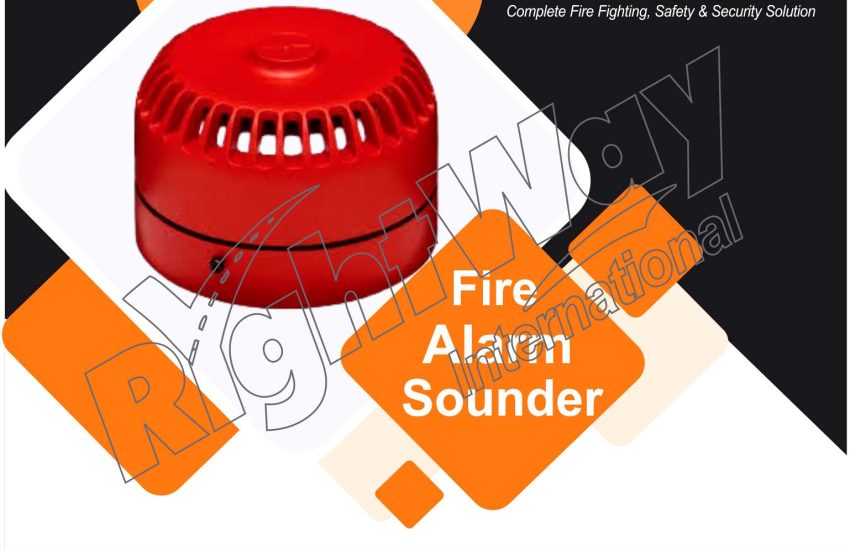Fire alarm sounders are essential components of any fire detection system. They use loud and distinctive sounds to alert building occupants to evacuate during an emergency. In this guide, you’ll learn about their function, types, benefits, installation practices, and maintenance tips to ensure effective performance.
📣 What Is a Fire Alarm Sounder?
A fire alarm sounder is a device that emits a loud and attention-grabbing noise when a fire is detected. It connects to the fire alarm control panel, which activates the sounder upon receiving signals from smoke or heat detectors. Because they are designed for high audibility, these devices are especially effective in noisy or crowded environments.
⚙️ How Fire Alarm Sounders Work
1. Activation
When a fire is detected, the control panel sends a signal to the sounder. This activates the device and causes it to emit a piercing noise.
2. Sound Production
The sounder then produces a loud tone—such as a bell, siren, or horn—depending on its design. These sounds are intentionally harsh to cut through ambient noise and capture attention.
3. Occupant Notification
The primary function is to notify everyone in the building of the emergency. It prompts immediate evacuation and activates the building’s emergency response protocols.
🔊 Types of Fire Alarm Sounders
1. Mechanical Bells
These traditional sounders use a striking hammer to produce a loud ringing sound. Although older, they are still in use for specific applications.
2. Electronic Sirens
Electronic sirens offer more flexibility. They produce customizable tones using electronic circuits and are widely used in modern systems.
3. Horns
Horns generate a sharp, loud tone. They are ideal in environments where other types of sound may not be as effective.
4. Chimes
Chimes produce short, repetitive tones. While less common as primary sounders, they can be used in combination with others to enhance recognition.
5. Combined Sounder-Visual Alerts
These units include both sound and visual indicators, such as flashing lights or strobes. They are especially valuable in areas with high ambient noise or for hearing-impaired individuals.
✅ Benefits of Fire Alarm Sounders
1. Immediate Notification
Sounders provide a clear, immediate warning, giving people the critical time needed to evacuate safely.
2. High Audibility
Their design ensures that the sound reaches even distant or noisy areas, which is crucial in factories, schools, or large commercial spaces.
3. Customizable for Any Setting
With a variety of models available—including those with visual alerts—fire alarm sounders can be tailored to meet the specific needs of different buildings.
🏗️ Installation Tips for Fire Alarm Sounders
1. Strategic Placement
Install sounders in central locations to ensure the sound reaches all areas. Don’t forget enclosed rooms, bathrooms, or machinery spaces.
2. Mounting Height
Mount them high enough to distribute sound effectively, but avoid placing them behind obstructions that could muffle their output.
3. Sound Level Requirements
Ensure the device meets local decibel level regulations. Test for audibility in all areas and adjust as necessary.
4. System Integration
Connect sounders properly to the fire alarm control panel. Make sure they activate as part of the full fire detection system.
🔧 Maintenance Practices
1. Regular Testing
Test the sounders according to the manufacturer’s guidelines and local fire codes. Confirm both activation and volume.
2. Cleaning
Dust and dirt can block sound output. Clean the units periodically using non-abrasive methods to maintain performance.
3. Visual Inspection
Check for damage, loose wires, or signs of tampering. Ensure that mounting brackets are secure.
4. Battery Check (if applicable)
Replace batteries at recommended intervals or when low-battery indicators are triggered.
5. Professional Servicing
Hire certified technicians for annual inspections. They can detect internal faults and ensure compliance with fire safety standards.
🧯 Conclusion
Fire alarm sounders are vital for occupant safety during a fire emergency. Their loud, attention-commanding tones help initiate swift evacuations and reduce panic. By understanding how they work and maintaining them properly, you ensure your fire safety system remains reliable when it matters most.


